Abstract
The workload and costs of the emergency admissions and treatment of adhesive small bowel obstruction (ASBO) are unclear. This review details and costs the admission workload of ASBO. All admissions over a 2-year period for ASBO at two district general hospitals were identified through ICD10 diagnostic codes. Diagnostic investigations, treatment patterns, ward stay and outcome information for admissions were detailed from clinical records to develop mean cost estimates and assess the associated workload. Of the 298 admissions identified, 188 were not due to ASBO and were excluded from analysis. Of the 110 admissions detailed, 41 (37%) were treated surgically and 69 (63%) conservatively. Most admissions occurred through general practitioner referral (86.4%) to accident and emergency (90.0%). Mean (SD) length of stay was 16.3 days (11.0 days) for surgical treatment and 7.0 days (4.6 days) for conservative treatment. In-patient mortality was 9.8% for the surgical group and 7.2% for the conservative group. Costs were based on the mean values from both centres for surgical and conservative admissions and detailed according to the cost of referral and follow-up (100.98 Pounds surgical versus 102.61 Pounds conservative), hospital ward and ICU stay (3,327.48 Pounds versus 1,267.92 Pounds), theatre time (832.32 Pounds surgical only), investigations (282.73 Pounds versus 207.33 Pounds) and drug costs (133.90 Pounds versus 28.29 Pounds). Total treatment cost per admission for ASBO was 4,677.41 Pounds for surgically treated admissions and 1,606.15 Pounds for conservatively treated admissions. The impact of admissions for ASBO is considerable in terms of both costs and workload. Bed stay for these admissions represents the equivalent of almost one surgical bed per year and at least 2 days theatre time, impacting on surgical capacity and waiting lists. Adhesion prevention strategies may reduce the workload associated with ASBO. The review provides useful information for planning resource allocation.
Full text
PDF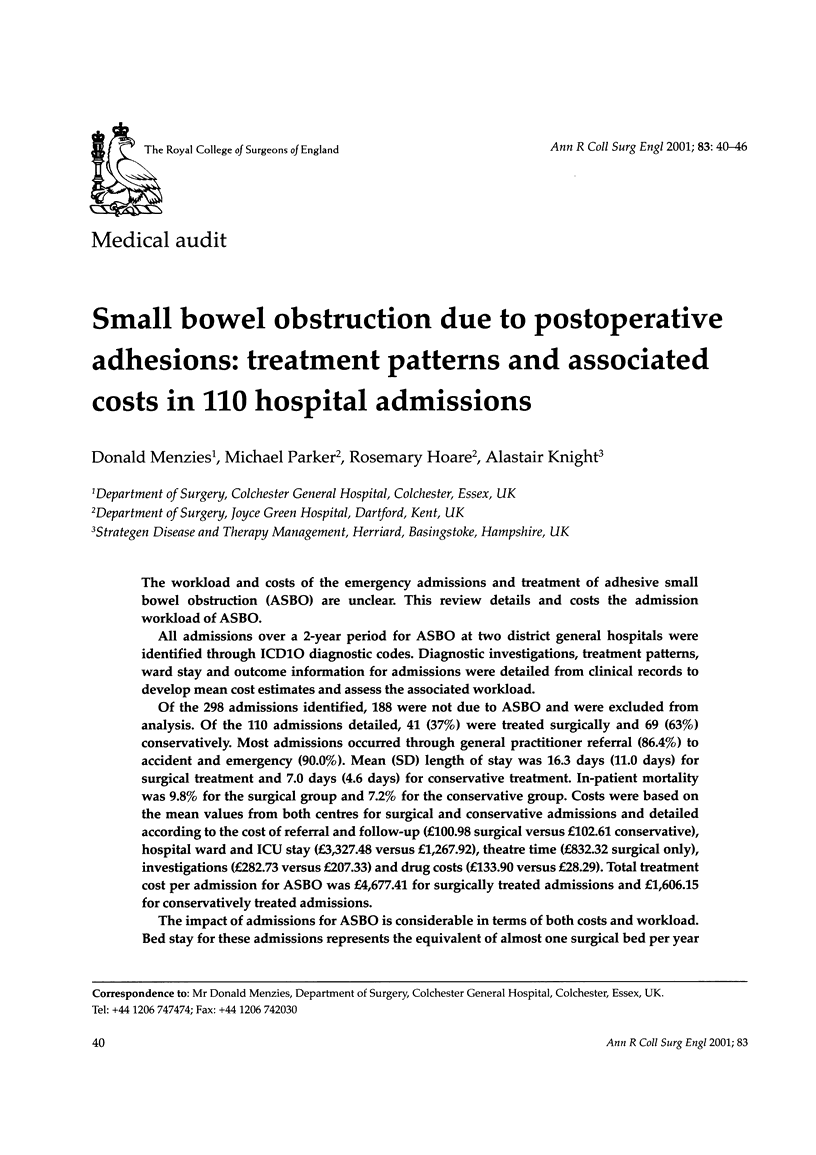
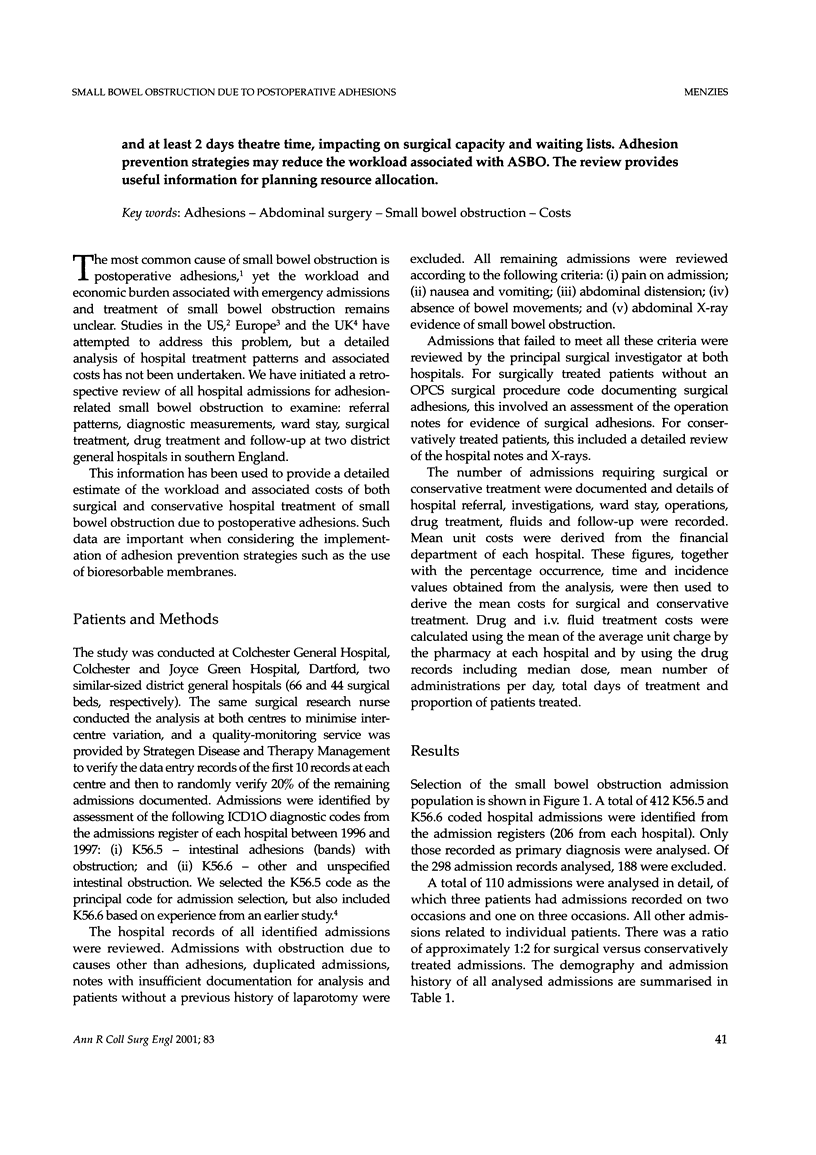
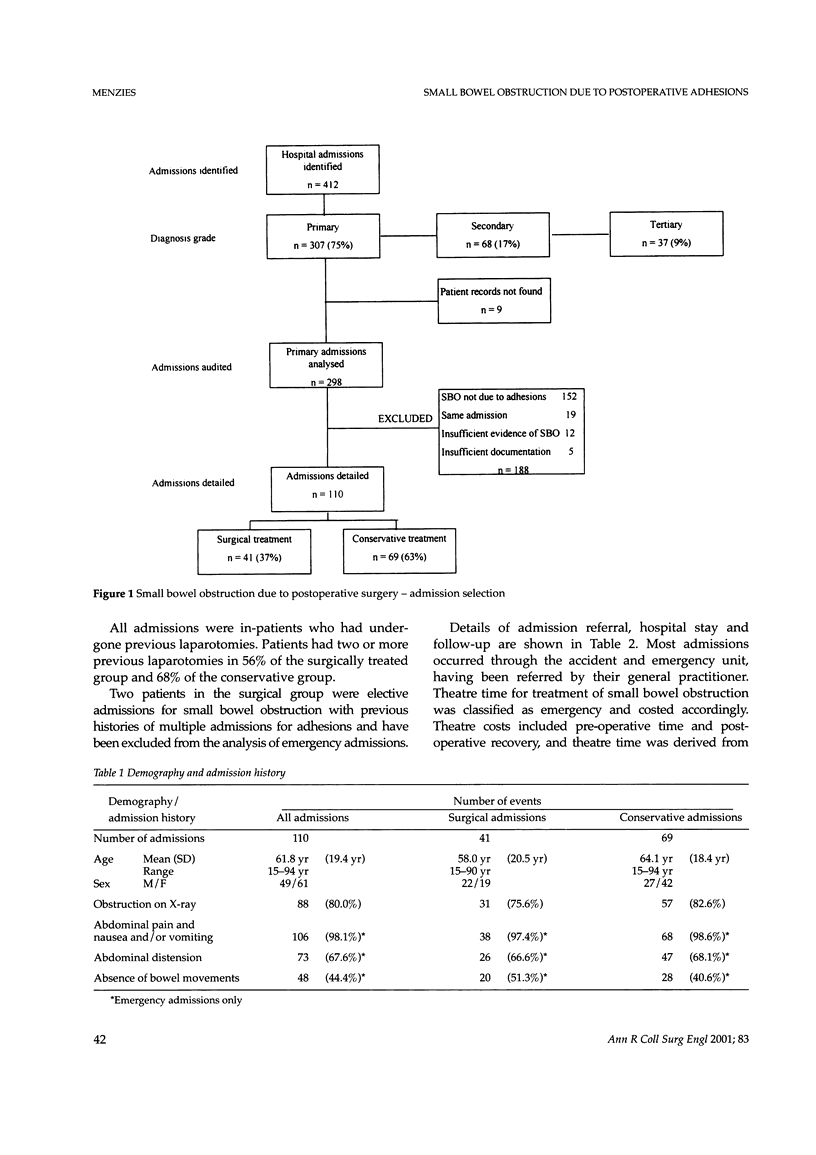


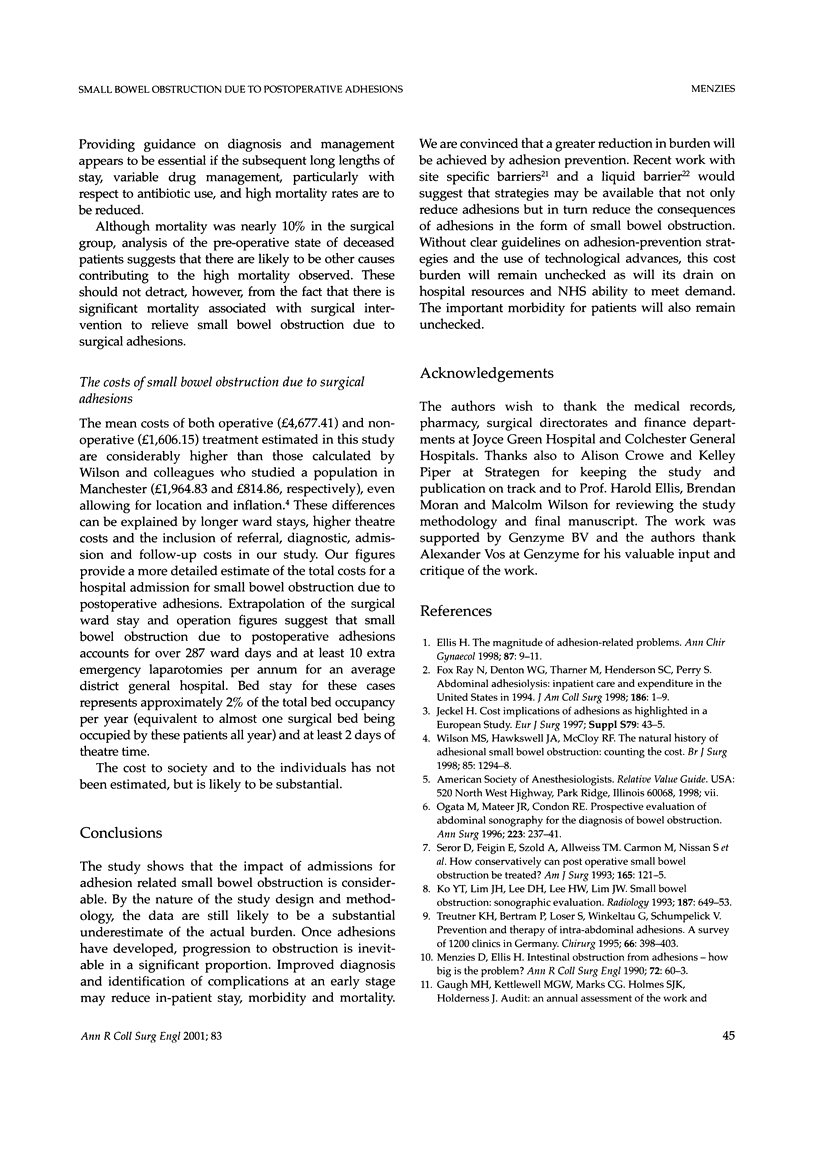
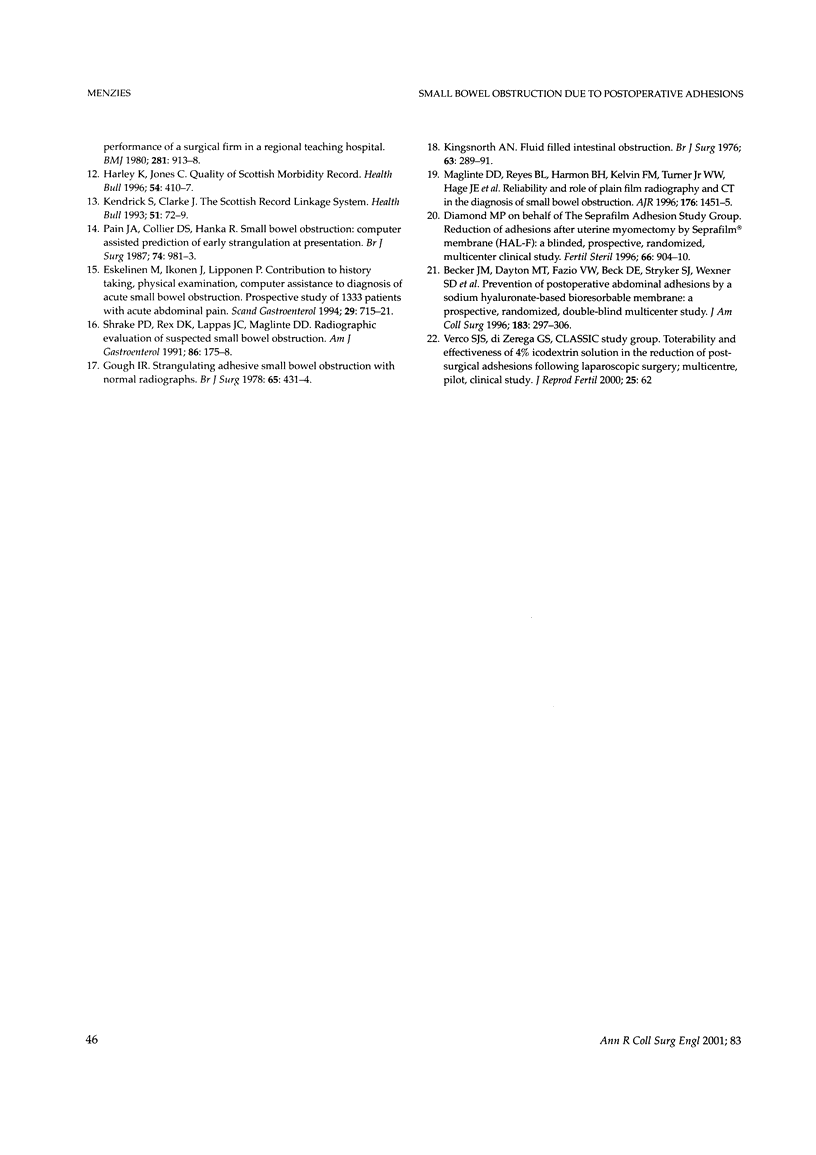
Selected References
These references are in PubMed. This may not be the complete list of references from this article.
- Becker J. M., Dayton M. T., Fazio V. W., Beck D. E., Stryker S. J., Wexner S. D., Wolff B. G., Roberts P. L., Smith L. E., Sweeney S. A. Prevention of postoperative abdominal adhesions by a sodium hyaluronate-based bioresorbable membrane: a prospective, randomized, double-blind multicenter study. J Am Coll Surg. 1996 Oct;183(4):297–306. [PubMed] [Google Scholar]
- Diamond M. P. Reduction of adhesions after uterine myomectomy by Seprafilm membrane (HAL-F): a blinded, prospective, randomized, multicenter clinical study. Seprafilm Adhesion Study Group. Fertil Steril. 1996 Dec;66(6):904–910. [PubMed] [Google Scholar]
- Ellis H. The magnitude of adhesion related problems. Ann Chir Gynaecol. 1998;87(1):9–11. [PubMed] [Google Scholar]
- Eskelinen M., Ikonen J., Lipponen P. Contributions of history-taking, physical examination, and computer assistance to diagnosis of acute small-bowel obstruction. A prospective study of 1333 patients with acute abdominal pain. Scand J Gastroenterol. 1994 Aug;29(8):715–721. doi: 10.3109/00365529409092499. [DOI] [PubMed] [Google Scholar]
- Gough I. R. Strangulating adhesive small bowel obstruction with normal radiographs. Br J Surg. 1978 Jun;65(6):431–434. doi: 10.1002/bjs.1800650618. [DOI] [PubMed] [Google Scholar]
- Gough M. H., Kettlewell M. G., Marks C. G., Holmes S. J., Holderness J. Audit: an annual assessment of the work and performance of a surgical firm in a regional teaching hospital. Br Med J. 1980 Oct 4;281(6245):913–918. doi: 10.1136/bmj.281.6245.913. [DOI] [PMC free article] [PubMed] [Google Scholar]
- Harley K., Jones C. Quality of Scottish Morbidity Record (SMR) data. Health Bull (Edinb) 1996 Sep;54(5):410–417. [PubMed] [Google Scholar]
- Kendrick S., Clarke J. The Scottish Record Linkage System. Health Bull (Edinb) 1993 Mar;51(2):72–79. [PubMed] [Google Scholar]
- Kingsnorth A. N. Fluid-filled intestinal obstruction. Br J Surg. 1976 Apr;63(4):289–291. doi: 10.1002/bjs.1800630409. [DOI] [PubMed] [Google Scholar]
- Ko Y. T., Lim J. H., Lee D. H., Lee H. W., Lim J. W. Small bowel obstruction: sonographic evaluation. Radiology. 1993 Sep;188(3):649–653. doi: 10.1148/radiology.188.3.8351327. [DOI] [PubMed] [Google Scholar]
- Maglinte D. D., Reyes B. L., Harmon B. H., Kelvin F. M., Turner W. W., Jr, Hage J. E., Ng A. C., Chua G. T., Gage S. N. Reliability and role of plain film radiography and CT in the diagnosis of small-bowel obstruction. AJR Am J Roentgenol. 1996 Dec;167(6):1451–1455. doi: 10.2214/ajr.167.6.8956576. [DOI] [PubMed] [Google Scholar]
- Menzies D., Ellis H. Intestinal obstruction from adhesions--how big is the problem? Ann R Coll Surg Engl. 1990 Jan;72(1):60–63. [PMC free article] [PubMed] [Google Scholar]
- Ogata M., Mateer J. R., Condon R. E. Prospective evaluation of abdominal sonography for the diagnosis of bowel obstruction. Ann Surg. 1996 Mar;223(3):237–241. doi: 10.1097/00000658-199603000-00002. [DOI] [PMC free article] [PubMed] [Google Scholar]
- Pain J. A., Collier D. S., Hanka R. Small bowel obstruction: computer-assisted prediction of strangulation at presentation. Br J Surg. 1987 Nov;74(11):981–983. doi: 10.1002/bjs.1800741107. [DOI] [PubMed] [Google Scholar]
- Seror D., Feigin E., Szold A., Allweis T. M., Carmon M., Nissan S., Freund H. R. How conservatively can postoperative small bowel obstruction be treated? Am J Surg. 1993 Jan;165(1):121–126. doi: 10.1016/s0002-9610(05)80414-3. [DOI] [PubMed] [Google Scholar]
- Shrake P. D., Rex D. K., Lappas J. C., Maglinte D. D. Radiographic evaluation of suspected small bowel obstruction. Am J Gastroenterol. 1991 Feb;86(2):175–178. [PubMed] [Google Scholar]
- Treutner K. H., Bertram P., Löser S., Winkeltau G., Schumpelick V. Prophylaxe und Therapie intraabdomineller Adhäsionen. Eine Umfrage an 1200 Kliniken in Deutschland. Chirurg. 1995 Apr;66(4):398–403. [PubMed] [Google Scholar]
- Wilson M. S., Hawkswell J., McCloy R. F. Natural history of adhesional small bowel obstruction: counting the cost. Br J Surg. 1998 Sep;85(9):1294–1298. doi: 10.1046/j.1365-2168.1998.00822.x. [DOI] [PubMed] [Google Scholar]


